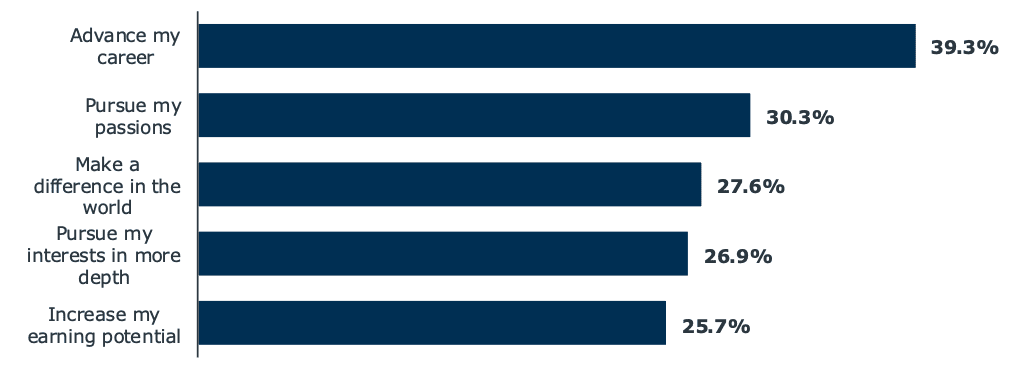We secret shopped 40 graduate programs’ lead nurturing campaigns. Here’s what we learned.
Universities are spending more than ever to generate leads, especially in the highly competitive market for graduate students, where costs per lead (CPLs) are commonly in the $500+ range. Despite this, many universities take a “set it and forget it” approach to their lead nurture campaigns, which are crucial for retaining those hard-earned leads. As a former Chief Marketing Officer in the digital ad spending wars, I’m always surprised by how many university leaders invest significant—and increasingly scarce—resources towards lead generation but haven’t reviewed their own campaigns.
I took that as a sign that there might be something to learn from that exercise, so I spent the last six months completing request for information (RFI) forms for 40 graduate programs across business, education, computer science, engineering, and health sciences at public, private, regional, and national universities.
The biggest takeaway? Most programs are not investing nearly enough in managing these leads as a valuable asset. Doing so requires dedicated strategy, staff expertise, time, and technological infrastructure. But a well-executed lead nurture campaign can be the deciding factor in the hard-fought race to become one of the four programs a lead applies to.
I graded the group of 40 programs I “secret shopped” across five key characteristics of an effective lead nurture strategy. Here’s where they landed.
Five key characteristics of effective lead nurture strategy
1. Responsive: Campaigns must be hyperpersonalized and respond to student intent and behavior
An effective lead nurture strategy uses student intent to personalize marketing messaging and cadence. Messages—and the cadence in which they’re sent—should adjust to the online/digital behaviors of your prospective students. Within EAB’s Adult Learner Recruitment division, we survey leads to understand their key motivators and reflect that messaging back to them, and activity throttles up or down depending on their engagement.
Overall grade: Fail
Almost 60% of schools used drip campaigns, which are automated emails scheduled to send on specific days, but all of them used their application deadlines to gauge when to reach out to students. In other words, they sent emails based on their own calendar rather than responding to the online behavior and signals from prospective students.

The most shocking finding was that nearly a quarter of the programs I reviewed sent one-off generic “copy and paste” emails from an admissions counselor and 18% of institutions sent nothing at all. Not one message engaging me as a prospective student. If I had been a real lead, it’s very likely I would lose interest in those institutions immediately.
2. Long-term: Campaigns must support prospects over longer decision timeframes
Effective lead nurture strategies are long-term, extending outreach to prospective students beyond one or two enrollment cycles. Our research shows that nearly 40% of adult learners take 12+ months to make a decision about where to enroll. We recommend building campaigns that extend over 18 to 20 months to capture this longer journey to enrollment.
Overall grade: Fail
Of the institutions that did send follow-up communication, 61% of them failed to continue outreach beyond their next application cycle.
3. Supportive: Campaigns must address student needs and concerns
Adult learners have different needs and concerns than first-time, full-time undergraduates—especially as it relates to your program costs and flexibility. Addressing student concerns around tuition, return-on-investment for the degree, financial aid, flexible options, and student support services for should be elevated in outreach.
Survey results: “What are your primary reasons for furthering your education?”
Asked of students who are currently enrolled or planning to enroll in the next 2 years. Top five responses shown.

Overall grade: Fail
Three-quarters of the schools focused their messaging exclusively on themselves: their application process, requirements, and deadlines. As a result, the emails from these schools felt like a one-way conversation, with no mention of the questions and concerns many prospective students weigh during their enrollment journey.
4. Multi-channel: Campaigns must engage students across multiple channels
A strong lead nurture program goes beyond email to reach students wherever they spend time. Outreach to leads should be integrated and coordinated across multiple touchpoints and channels based on where prospects spend their time: email, direct mail, text, and digital ad remarketing on social media to name a few. By integrating your campaign across touchpoints, students will receive consistent messaging that builds upon itself across multiple channels.
Overall grade: Fail
Less than 10% of schools retargeted me on other channels (newsletters, social media, digital display ads, etc.). This means that nearly all programs I studied missed out on opportunities to reach students where they are and improve their user experience.
5. Relatable: Campaigns must build human connections with students
In today’s world of AI-driven email communications, students are wary of automated messages. Does your email sound relatable and like it’s from a human—or does it use bot-like language? Differentiating yourself in a stream of automated higher ed touchpoints (which will only ramp up with AI) means breaking up from automated emails every few weeks, and instead opting to send a quick personalized note, pick up the phone and call or try sending a note in the mail.
Overall grade: Fail
Less than 30% of the institutions I secret shopped had an admissions counselor or program director send me a direct message offering to connect me to further resources or answer my questions. The remaining schools (72%) sent automated drip campaign emails from a general “University Admissions” team without counselor contact information.
If you’re worried that your RFI wouldn’t get a passing grade in my scan, try getting on a “seed list” or completing a RFI on your own site to evaluate your content. Pay special attention for ways to 1) introduce content aimed at students’ priorities; 2) leverage multiple channels to reach students; and 3) test into responsive communications. And as a general rule of thumb, prepare to allocate as many resources to nurturing your leads as you do to acquiring them in the first place.

More Blogs

When Grad PLUS disappears: What 8,000+ grad students said about paying for school

4 predictions for 2026: What’s next for graduate and online enrollment
